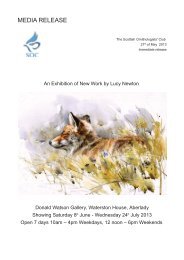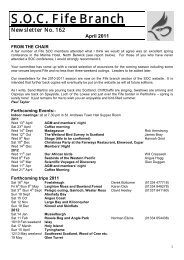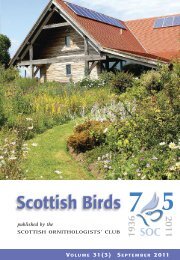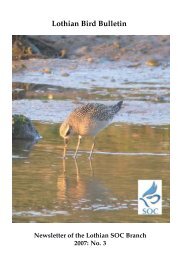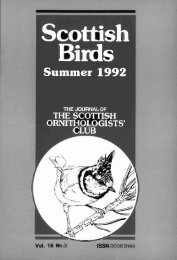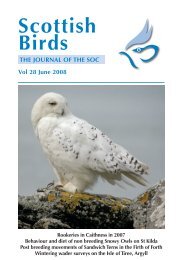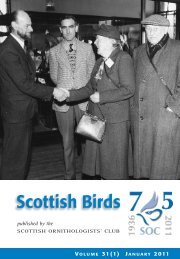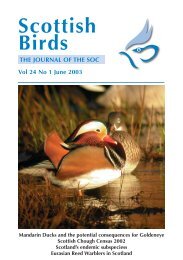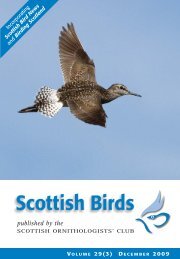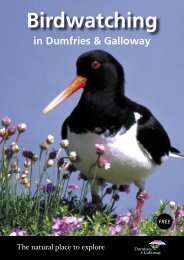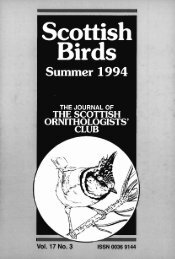Birdwatching in Dumfries & Galloway - The Scottish Ornithologists ...
Birdwatching in Dumfries & Galloway - The Scottish Ornithologists ...
Birdwatching in Dumfries & Galloway - The Scottish Ornithologists ...
You also want an ePaper? Increase the reach of your titles
YUMPU automatically turns print PDFs into web optimized ePapers that Google loves.
1. Mull of <strong>Galloway</strong>RSPB reserveCCTV2. New England Bay and eastRh<strong>in</strong>s coast roadsHabitats: Coastal cliffs, maritimeheath.Birds: Largest ma<strong>in</strong>land seabirdcolony <strong>in</strong> southwest Scotland: Fulmar,Guillemot, Razorbill, Kittiwake, Shag,Black Guillemot and a few Puff<strong>in</strong>s.Offshore there may be Gannets,petrels and shearwaters. Breed<strong>in</strong>gPeregr<strong>in</strong>e, Kestrel, Stonechat,Wheatear and Rock Pipit.Facilities: <strong>The</strong> RSPB reserve liesbeyond the lighthouse wall, and isopen at all times. <strong>The</strong> Visitor centreopens daily, 10am - 5pm, from Easteruntil mid-October. Live CCTV of theseabird colony. Toilets, café and shopnear lighthouse. Disabled park<strong>in</strong>g baynext to visitor centre.How to get there: Follow A716to Drummore, then by sign-postedm<strong>in</strong>or roads.Contact: 01776 840539 or 01671404975.www.rspb.org.uk/reservesGuillemotHabitats: Sand, sh<strong>in</strong>gle and boulderbeaches, gorse scrub, woodland andfarmland with secret glens.Birds: Gannets, divers, Red-breastedMerganser, Eider, Shearwaters andterns offshore. Waders, CommonWhitethroat, warblers, Stonechat,Wheatear, pipits, and Yellowhammer.Facilities: Roadside park<strong>in</strong>g afford<strong>in</strong>gexcellent views. Public toilets at NewEngland Bay, Ardwell and Drummore.How to get there: <strong>The</strong> A716 closelyfollows the shore between Sandheadand Drummore. Tak<strong>in</strong>g the B7065 toPort Logan forms a good circular routeto Drummore tak<strong>in</strong>g <strong>in</strong> the west Rh<strong>in</strong>scoast.3. Southern Upland Way,Portpatrick to Killantr<strong>in</strong>ganHabitats: Coastal cliffs, pebblebeach, scrub and farmland.Birds: Black Guillemot nest <strong>in</strong> theharbour walls. Fulmar and Herr<strong>in</strong>gGull nest on the cliffs. Look outfor Peregr<strong>in</strong>e, Raven, Rock Pipit,L<strong>in</strong>net and Stonechat. Gannets andshearwaters offshore.Facilities: Car park<strong>in</strong>g at Portpatrickharbour and near Killantr<strong>in</strong>ganlighthouse. Toilets at Portpatrick.Signposted clifftop walk, steep <strong>in</strong>places.How to get there: <strong>The</strong> start ofthe Southern Upland Way is at thenorth end of Portpatrick harbour.Killantr<strong>in</strong>gan lighthouse is reachedby tak<strong>in</strong>g a m<strong>in</strong>or road off the A764lead<strong>in</strong>g north from Portpatrick.3
4. Corsewall Po<strong>in</strong>tHabitats: Rocky shore and cliff topwalk<strong>in</strong>g.Birds: Autumn seawatch<strong>in</strong>g site forStorm Petrel, Sab<strong>in</strong>e’s Gull, Gannet,skuas and shearwaters. Best dur<strong>in</strong>gand immediately after strongnorthwesterly gales.Facilities: Informal car park<strong>in</strong>g.How to get there: A718 north fromStranraer to Kirkcolm, then m<strong>in</strong>orroads.Eider Duck5. Loch RyanHabitats: Sea loch and mudflats,sh<strong>in</strong>gle spur.Birds: W<strong>in</strong>ter<strong>in</strong>g divers, grebes,waders and wildfowl <strong>in</strong>clud<strong>in</strong>g Scaupand Brent Geese. Summer - Breed<strong>in</strong>gterns.Facilities: Paved and tarmac walksalong the sea front at Stranraersuitable for disabled birdwatchers,views from parked cars at Wig Bay,Broadstone, Balyett and Innermessan.Information boards at Balyett, WigBay and Cairnryan. Toilets at Balyettand on the Stranraer Waterfront.Access: Easy access at Wig Bay andBroadstone to Cairnryan is accessibleto wheelchairs users us<strong>in</strong>g a lochsidecycle path. <strong>The</strong>re are good views fromthe roadside at Wig Bay and all alongthe south eastern shore.How to get there: A77 closelyfollows the south eastern shore. Forwestern shore take A718 west fromStranraer, then north to Wig Bay.Contact: DGC Ranger Service01988402401.Gannets4
<strong>The</strong> Machars<strong>The</strong> two best birdwatch<strong>in</strong>g areas <strong>in</strong> this part of Wigtownshire are alongthe rocky coastl<strong>in</strong>e and at Wigtown Bay where there are mudflats andsaltmarshes. <strong>The</strong> moorland areas around Mochrum Loch can also beworth a visit.St N<strong>in</strong>ian’s Cave5
6. Castle Kennedy Gardensand White LochHabitats: Mature mixed woodland,formal gardens, two lochs.Birds: Woodland birds and wildfowl,especially Greylag and Canada Geese.Facilities: Shop, tearoom and toilets.Open April to September (admissioncharge).How to get there: Signposted fromA75.Contact: 01776 702024.www.castlekennedygardens.co.uk7. Luce Bay shore road –Auchenmalg to MonreithHabitats: Predom<strong>in</strong>antly sh<strong>in</strong>glebeaches with maritime cliff and slope.Status: Luce bay is a Special Area ofConservation.Birds: Stonechat, Common andLesser Whitethroat, Pied Wagtail,Oystercatcher, R<strong>in</strong>ged Plover, Curlew,Cormorant. Gannets and ternsoffshore. F<strong>in</strong>ch flocks on the strandl<strong>in</strong>e<strong>in</strong> w<strong>in</strong>ter.Facilities: Information boards atlay-bys, shops, hotels at Port William.Public Toilets at Stairhaven, PortWilliam and Monreith.Access: Cliff top path south fromStairhaven to Auchenmalg (5 milesreturn). Numerous lay-bys alongA747.8. Isle of Whithorn to St. N<strong>in</strong>ian’sCaveHabitats: Coastal cliffs and sh<strong>in</strong>gle,maritime heath and low scrub.Birds: Black Guillemot, Shag, Fulmar,Peregr<strong>in</strong>e, Raven and Twite.6Fulmar
Facilities: Coastal footpath, (4 milesreturn – 5.5 miles if start<strong>in</strong>g fromKidsdale). Car park, toilets and hotelsat the Isle of Whithorn.Access: On the B7004 from Whithornfollow road signs to St. N<strong>in</strong>ian’sCave, (leave car at Kidsdale car parkfor a longer walk <strong>in</strong>corporat<strong>in</strong>g 1.5mile woodland stretch). Park<strong>in</strong>g alsoavailable at Isle of Whithorn.9. Garlieston Bay and CruggletonBayHabitats: Rocky shore andbroadleaved woodland.Birds: Oystercatcher, Turnstone,Redshank, occasional Greenshank,Cormorant, Black Guillemot andHouse Mart<strong>in</strong>s on Cruggleton cliffs.Facilities: Toilets and car park<strong>in</strong>g <strong>in</strong>Garlieston and park<strong>in</strong>g at <strong>Galloway</strong>House Gardens.How to get there: Follow B7004south from Wigtown to Garlieston. Atcrossroads take m<strong>in</strong>or road opposite<strong>in</strong>to the grounds of <strong>Galloway</strong> Housefor Cruggleton Bay, or turn left forGarlieston Bay.Osprey10. Wigtown Bay LocalNature ReserveCCTVHabitats: Saltmarsh, mudflats andsandflats. Freshwater wetland.Status: <strong>The</strong> largest LNR <strong>in</strong> Brita<strong>in</strong>with the largest area of saltmarsh andmudflats on the outer Solway.Birds: Internationally important forw<strong>in</strong>ter<strong>in</strong>g P<strong>in</strong>k-footed Geese andnationally important for P<strong>in</strong>tail,Whooper Swan and Curlew. Breed<strong>in</strong>gand passage waders, ducks and terns.Facilities: Hide at Wigtown harbourwith views over the River Bladnoch,saltmarsh and freshwater wetland.<strong>The</strong> hide has access for the disabled.Information boards at the harbour,Martyrs’ Stake and Carsluith Castle.Walks (mostly wheelchair accessible)start<strong>in</strong>g from Wigtown Harbour andMartyrs’ Stake.Visitor Centre: Displays and acommand<strong>in</strong>g view of the bay fromWigtown County Build<strong>in</strong>gs (open<strong>in</strong>gtimes Mon to Sat 10am to 5pm,special 7.30pm open<strong>in</strong>g on Tuesday,Wednesday and Friday; Sunday 2pmto 5pm). CCTV of Ospreys breed<strong>in</strong>g<strong>in</strong> <strong>Galloway</strong> dur<strong>in</strong>g summer andwetland birds <strong>in</strong> w<strong>in</strong>ter. Accessible towheelchair users.Access: Roadside lay-bys on A75 nearCreetown and Carsluith, park<strong>in</strong>g atMartyrs’ Stake and Wigtown harbour.How to get there: <strong>The</strong> A75 followsthe eastern shore and for west shorefollow A714 from Newton Stewart toWigtown.Contact: DGC Ranger Service 01988402401 email wblnr@dumgal.gov ukand www.dgcommunity.net/wblnr7
11 Kirroughtree Forest Papy Ha’Bird Trail, FCSHabitats: Broadleaved andconiferous woodland, scrub andstreamside meadow.Birds: Tawny Owl, Buzzard, Sisk<strong>in</strong>,Common Crossbill, Great SpottedWoodpecker and several warblerspecies, <strong>in</strong>clud<strong>in</strong>g Wood Warbler andCommon Whitethroat.Facilities: Car park, visitor centrewith wildlife on CCTV, tearoom,toilets, signposted 3.5 and 5 milefootpaths. Leaflet available. Forestdrive from Easter to end of October(admission charge).How to get there: 4 miles east ofNewton Stewart. Kirroughtree Forestis signposted off A75 at Palnure.Contact: Forestry CommissionScotland 01671 402420Sisk<strong>in</strong>Stonechat12. Wood of Cree & Barclye FarmRSPB ReserveHabitats: Ancient oak woodland,scrub, freshwater marsh, newwoodland plant<strong>in</strong>g, pasturewoodland.Birds: Important numbers ofbreed<strong>in</strong>g Pied Flycatcher, Redstartand Wood Warbler, as well asSpotted Flycatcher, Nuthatch,Great Spotted Woodpecker, TawnyOwl, Sparrowhawk and a suiteof woodland birds. Tree Pipit,Grasshopper Warbler, Whitethroat,Blackcap and Garden Warbler breedon the scrubland trail. Reed Bunt<strong>in</strong>g,Willow Tit, Grey Wagtail and SedgeWarbler breed close to the river, andcan be seen from the otter platform.Occasional Osprey.<strong>The</strong> reserve extension at BarclyeFarm supports breed<strong>in</strong>g TreePipit, Redstart, Spotted Flycatcher,Barn Owl, Tawny Owl, Wh<strong>in</strong>chat,Stonechat, Wheatear, Snipe andCurlew, and w<strong>in</strong>ter<strong>in</strong>g thrushes.Facilities: Car park, <strong>in</strong>formationboard, otter view<strong>in</strong>g platform, 1 milesignposted trail with 1 mile extension.Please contact RSPB for <strong>in</strong>formationon access and facilities at BarclyeFarm.How to get there: <strong>The</strong> reserve lieson the east bank of the River Cree4 miles north of Newton Stewart.Take m<strong>in</strong>or roads from M<strong>in</strong>nigaffto Glentrool, or from the A714 justsouth of Bargrennan.Contact: 01671 404975www.rspb.org.uk/reserves8
Loch KenStewartry of Kirkcudbright<strong>The</strong> Stewartry has a tremendous variety of habitats – highbarren hills, remote lochs, tumbl<strong>in</strong>g rivers, swathes of coniferplantation, pockets of oak woodland, fertile lowlands and arugged coastl<strong>in</strong>e – Scotland <strong>in</strong> m<strong>in</strong>iature. It’s easy to see a widerange of bird species <strong>in</strong> a short period.9
13. Glentrool, part of <strong>Galloway</strong>Forest ParkHabitats: Coniferous andbroadleaved woodland, heathermoorland, freshwater lochs andburns.Loch TroolBirds: Sisk<strong>in</strong>, Common Crossbill,Barn Owl, Tawny Owl, Buzzard, PiedFlycatcher and Redstart. In moorlandareas: Wheatear, Dipper, Peregr<strong>in</strong>eand Raven.Facilities: Car parks at Bruce’s Stone,Caldons and Stroan Bridge visitorcentre. Waymarked trails, <strong>in</strong>clud<strong>in</strong>gcircular footpath around LochTrool that <strong>in</strong>corporates part of theSouthern Upland Way. Informationboards at Stroan Bridge and Caldons.How to get there: 10 miles northof Newton Stewart. Signposted fromBargrennan and Glentrool Village.Contact: Forestry CommissionScotland 01671 40242014. Southern Upland Way –Manquhill circular walkHabitats: Conifer and broadleavedplantation (private forestry), pondsand hill graz<strong>in</strong>g.Birds: Skylark, Meadow Pipit, Raven,Kestrel, Curlew. In w<strong>in</strong>ter, Merl<strong>in</strong> andHen Harrier.Facilities: Car park near east side ofStroanfreggan Bridge.Access: 5.5 or 7.5 mile circular walks<strong>in</strong>corporat<strong>in</strong>g part of the SouthernUpland Way.How to get there: On B729Moniaive to Carsphairn road at NX646918.15. Raiders Road ForestDrive FCSHabitats: Conifer plantation, birchwoodland, loch and river.Birds: Sisk<strong>in</strong>, Common Crossbill,Red Kite, Buzzard, Grey Wagtail,Dipper, Common Sandpiper, Nightjar.Waterfowl on Loch Stroan, <strong>in</strong>clud<strong>in</strong>gGreat Crested Grebe and Goldeneye.10Tawny Owl
Facilities: Clatter<strong>in</strong>gshaws ForestWildlife Centre at Clatter<strong>in</strong>gshawswith tearoom and toilets. Informationboard and toilets near mid-po<strong>in</strong>t ofdrive. Leaflet available.Access: Untarred forest road openEaster to end of October (admissioncharge).How to get there: Off A712 atClatter<strong>in</strong>gshaws Dam, or off A762 atMossdale.Contact: Forestry CommissionScotland 01671 402420.16. Carstramon Woods SWTHabitats: Broadleaved woodlandwith many oaks and spr<strong>in</strong>gtimeBluebells.17. Cally Woods FCSHabitats: Oak woodland and mixedforest.Birds: Great Spotted Woodpecker,Buzzard, Jay, Woodcock.Facilities: Car park, waymarkedtrails, unmanned visitor centre.How to get there: Drive towardsCally Palace Hotel, entrance off oldA75 at east end of Gatehouse.Contact: Forestry CommissionScotland 01671 402420.18. Balcary HeughsHabitats: Coastal cliffs, farmland,woodland, scrub and freshwater loch.Birds: Fulmar, Cormorant, Guillemot,Razorbill, Kittiwake, Rock Pipit,L<strong>in</strong>net, Stonechat.Facilities: Car park at road end,<strong>in</strong>formation board with map.Access: Circular walk <strong>in</strong>cludes LochMackie and Rascarrel Bay. Steep cliffs,take care.Pied FlycatcherBirds: Redstart, Pied Flycatcher,Wood Warbler, Buzzard.Facilities: Information board andfootpaths. Limited park<strong>in</strong>g.How to get there: M<strong>in</strong>or roads for2.5 miles north of Gatehouse of Fleet.CormorantHow to get there: Take m<strong>in</strong>orroad southwards from Auchencairnto Balcary car park. <strong>The</strong>re are alsobirdwatch<strong>in</strong>g opportunities alongthe shore road to Balcary (Shelduck,waders and gulls).11
19. Doach Woods FCSHabitats: Conifer forest, <strong>in</strong>clud<strong>in</strong>g40m high Douglas Firs.Birds: Sisk<strong>in</strong>, Common Crossbill,Buzzard, Raven, Green and GreatSpotted Woodpecker.Facilities: Car park, waymarkedtrails, viewpo<strong>in</strong>t, leaflet.How to get there: Car park on B736,4 miles south of Castle Douglas.Contact: Forestry CommissionScotland (Conservation Manager)01387 860247.Carl<strong>in</strong>gwark LochHow to get there: Adjacent to thesouth end of Castle Douglas.Contact: DGC Ranger Service 01556505479.21. Threave Estate andWildfowl Reserve NTS20. Carl<strong>in</strong>gwark LochView from Doach WoodsHabitats: Freshwater loch, willowcarr, alder carr and reedbeds.Birds: Great Crested Grebe, LittleGrebe, Goldeneye, Tufted Duck, Cootand other waterfowl. Moult<strong>in</strong>g MuteSwans <strong>in</strong> July and August.Facilities: Car park <strong>in</strong> LochsidePark, <strong>in</strong>formation board and toilets.3.5 mile circular walk along whichthere is a small wildlife view<strong>in</strong>g hideoverlook<strong>in</strong>g a secluded part of theloch.Habitats: Farmland, woodland,marshes, river, old railway-l<strong>in</strong>e.Birds: Greylag, P<strong>in</strong>k-footed andGreenland white-fronted Geese.Whooper Swans and other wildfowl,<strong>in</strong>clud<strong>in</strong>g occasional Smew. Summervisitors <strong>in</strong>clude Osprey, PiedFlycatcher, Common Whitethroat,Sedge Warbler, Grasshopper Warbler.W<strong>in</strong>ter<strong>in</strong>g raptors.Greenland White-fronted Geese12
Facilities: Countryside Centre andwoodland hide at Threave Gardens.Car park at Kelton Ma<strong>in</strong>s farm forThreave Castle; five hides. Admissioncharges for gardens and castle(Historic Scotland).Access: Circular estate walk fromThreave Gardens. Riverside hidesand Blackpark Marshes reached fromfootpath to Threave Castle; LambIsland hide access from old railwayl<strong>in</strong>esection of estate walk. All abilityaccess to one riverside hide from theThreave Castle car park.How to get there: Threave Castleand Gardens are signposted atroundabout at west end of CastleDouglas bypass.Contact: National Trust for ScotlandRanger Service 0844 493 2244.22. <strong>Galloway</strong> Kite Trailaround Loch Ken and vic<strong>in</strong>ityHabitats: Farmland, woodland,freshwater loch, river, marshes.Birds: Red Kites (first released<strong>in</strong> <strong>Galloway</strong> <strong>in</strong> 2001). W<strong>in</strong>ter<strong>in</strong>gGreenland White-fronted Geese.Breed<strong>in</strong>g woodland birds, wadersand wildfowl. Occasional Osprey andother raptors.Facilities: Signposted vehicle /cycle trail, with waymarked walks,<strong>in</strong>formation po<strong>in</strong>ts and view<strong>in</strong>glocations, <strong>in</strong>clud<strong>in</strong>g roadsideviewpo<strong>in</strong>ts by A713 and from A762near Mossdale, trail leaflet. SecretCages where kites were kept andreleased. Kite feed<strong>in</strong>g station atBellymack Hill Farm, near Laurieston,openall day,Red Kitefeed<strong>in</strong>gat 2pm(admission charge).How to get there: <strong>The</strong>Trail is signposted off the A75 nearCastle Douglas, and from A713 atKen Bridge. Trail guide leaflets areavailable at TICs, <strong>in</strong>formation po<strong>in</strong>tsand various bus<strong>in</strong>esses around thetrail.Contact: RSPB 01556670464 (office hours only).www.gallowaykitetrail.com23. Red Kite Feed<strong>in</strong>g StationFacilities: Hide; car park (smalladmission charge to feed<strong>in</strong>g station).Daily at 2.00pm food is put outand attracts wild Red Kites <strong>in</strong> goodnumbers. Buzzards andRavens can also beseen.Bellymack Hill Farmon the outskirts ofLaurieston village(east) on theB795 Tel: 01644450202.13
24. Loch Ken/ River DeeMarshes RSPB ReserveHabitats: Mixed broadleavedwoodland, fen, marsh, open water.Birds: Breed<strong>in</strong>g Willow Tit, PiedFlycatcher, Redstart, Wood Warbler,Great Spotted Woodpecker,Nuthatch, Red Kite, Sparrowhawk,Water Rail, Grasshopper Warbler,Snipe, Redshank, Lapw<strong>in</strong>g. GreenlandWhite-fronted Geese on nearbyfarmland <strong>in</strong> w<strong>in</strong>ter.Facilities: Car park at Ma<strong>in</strong>s ofDuchrae, <strong>in</strong>formation board,illustrated trail, two hides (1 and 1.5miles from car park), disabled park<strong>in</strong>gbay at hide, wheelchair access tohide, goose view<strong>in</strong>g platform (0.5miles from car park).How to get there: <strong>The</strong> reservelies on the west side of the LochKen/River Dee and is reached by am<strong>in</strong>or road off the B795 north ofGlenlochar. If you stop en-routeplease do not park <strong>in</strong> the pass<strong>in</strong>gplaces.Contact: 01671 404975.www.rspb.org.uk/reserves25. Knowetop LochsHabitats: Freshwater lochs, birchwoodland, fenland, heathland andsphagnum bog.Birds: Greylag Goose, WaterRail, Woodcock, Sedge Warbler,Grasshopper Warbler, Willow Tit,Raven and Crossbill.Facilities: Lay-by near ma<strong>in</strong> entrance.How to get there: 4 miles west ofCorsock on the A712.Contact: <strong>Scottish</strong> Wildlife Trust 0131312 7765.26. Auchenreoch LochHabitats: Freshwater loch and fr<strong>in</strong>geof woodland.Birds: Mute Swan, Greylag Geese,Goosander and other ducks.Occasional Smew <strong>in</strong> w<strong>in</strong>ter.Facilities: Lay-bys at western end. Donot attempt to park at east end.How to get there: 1 mile west ofCrocketford on A75.14Loch Ken
27. Milton LochHabitats: Freshwater loch, emergentvegetation, farmland.Birds: W<strong>in</strong>ter<strong>in</strong>g ducks and geese.Reed Bunt<strong>in</strong>g and Great CrestedGrebe.Facilities: Limited roadside park<strong>in</strong>g.How to get there: Take m<strong>in</strong>or roadsouthwards from Crocketford on A75.28. Loch ArthurWigeonHabitats: Freshwater loch, emergentvegetation, broadleaved andconiferous woodland.Birds: Great Crested Grebe, LittleGrebe, w<strong>in</strong>ter<strong>in</strong>g ducks and geese.Facilities: Roadside park<strong>in</strong>g.How to get there: A711 toBeesw<strong>in</strong>g, then take m<strong>in</strong>or road halfmile eastwards towards New Abbey.29. Mabie Forest FCSHabitats: Coniferous andbroadleaved woodland, freshwaterloch.Birds: Sisk<strong>in</strong>, Common Crossbill,Bullf<strong>in</strong>ch, Buzzard, Jay, PiedFlycatcher, Redstart, Raven, GreatSpotted Woodpecker, GreenWoodpecker and Wood Warbler.Facilities: Pay car park, toilets, picnicsite with barbecue pits, waymarkedtrails, cycle routes, leaflet. Hide atLochaber Loch.How to get there: 5 miles southwestof <strong>Dumfries</strong>. Signposted off A710<strong>Dumfries</strong> / New Abbey road.Contact: Forestry CommissionScotland (Conservation Manager)01387 860247.30. Dalbeattie Forest FCSHabitats: Coniferous andbroadleaved woodland, freshwaterloch.Birds: Sisk<strong>in</strong>, Common Crossbill,Coal Tit, Heron, Chiffchaff, WillowWarbler.Great Crested GrebeChaff<strong>in</strong>ch15
Facilities: Car park, waymarkedtrails, cycle routes, all-abilities trail.How to get there: On southernedge of Dalbeattie, off A710 toSandyhills.Contact: Forestry CommissionScotland (Conservation Manager)01387 860247.31. Rockcliffe NTSHabitats: Estuary, rocky shore,woodland meadow and scrub.Restricted access to Rough Islanddur<strong>in</strong>g May and June because ofbreed<strong>in</strong>g birds.How to get there: Off the A710towards Rockcliffe. (Please use carparks provided).Contact: National Trust for ScotlandRanger Service (0844 493 2244).32. Rockcliffe to SandyhillsHabitats: Coastal cliffs, scrub andfarmland.Birds: Especially noted for the largecolony of breed<strong>in</strong>g Cormorantsat Port O’Warren. Also Fulmar,Guillemot, Razorbill, Rock Pipit andRaven.Facilities: Signposted coastalfootpath; car parks and toilets atboth ends.How to get there: Off the A710towards Rockcliffe or off A710towards Sandyhills to start from here.(Please use car parks provided).R<strong>in</strong>ged PloverBirds: Scaup, and Red-throatedDiver <strong>in</strong> w<strong>in</strong>ter. Large numbers ofscoters on Solway but usually ratherdistant. Greenshank regular, exceptmid summer. Breed<strong>in</strong>g R<strong>in</strong>ged Plover,Oystercatcher, Common Whitethroat.Facilities: Car parks, disabled toilet,signposted footpaths, viewpo<strong>in</strong>ts.Colvend Coastl<strong>in</strong>e16
Blackshaw Caerlaverock<strong>The</strong> Inner Solway<strong>The</strong> Solway flats and marshes are <strong>in</strong>ternationally important forten species of overw<strong>in</strong>ter<strong>in</strong>g waterfowl (Whooper Swan, P<strong>in</strong>kfootedGoose, Barnacle Goose, P<strong>in</strong>tail, Scaup, Oystercatcher,Knot, Bar-tailed Godwit, Curlew and Redshank) and nationallyimportant for a further n<strong>in</strong>e species (Great Crested Grebe,Cormorant, Shelduck, Teal, Common Scoter, R<strong>in</strong>ged Plover,Golden Plover, Grey Plover and Sanderl<strong>in</strong>g).Some of these species, and a few others, have a limiteddistribution <strong>in</strong> <strong>Dumfries</strong> and <strong>Galloway</strong>: the <strong>in</strong>ner Solway area isthe best places to see Barnacle Goose, Whooper Swan, Bar-tailedGodwit, Knot, Purple Sandpiper, Sanderl<strong>in</strong>g and skuas.17
33. Mersehead RSPBReserveHabitats: Wetland, saltmarsh, sanddunes, sandflats and arable rotation/grassland.Barnacle GeeseBirds: Internationally important forw<strong>in</strong>ter<strong>in</strong>g Svalbard Barnacle Geese,P<strong>in</strong>tail and Teal. Other wildfowl<strong>in</strong>clude P<strong>in</strong>k-footed Geese, WhooperSwan, Wigeon, Shoveler andShelduck. Peregr<strong>in</strong>e, Hen Harrier andMerl<strong>in</strong>. Passage/w<strong>in</strong>ter<strong>in</strong>g wadersand f<strong>in</strong>ch flocks. Good numbersof breed<strong>in</strong>g wetland waders andSkylark. Reed Warbler and Water Railhave colonised. Seabirds and sea-duckoffshore.Facilities: Visitor Centre, two hides,wetland and coastal trails.Sulwath Centre (education/tra<strong>in</strong><strong>in</strong>g/volunteer<strong>in</strong>g).How to get there: Signposted m<strong>in</strong>orroad off A710 at Caulkerbush.Contact: 01387 780 579 / 298.mersehead@rspb.org.uk34. SouthernessHabitats: Sand and mudflats, rockyshore, maritime heath and sanddunes.Birds: One of the best places onthe Solway to see w<strong>in</strong>ter<strong>in</strong>g waders,especially flocks of Knot, Dunl<strong>in</strong>, BartailedGodwit, Grey Plover, GoldenPlover, Oystercatcher. <strong>The</strong> PurpleSandpipers, divers, grebes, auks,scoters and other sea ducks are bestseen opposite the lighthouse.Facilities: Park<strong>in</strong>g and toilets <strong>in</strong>Southerness village.35. CarsethornOystercatcherHabitats: Mudflats, mussel beds andreedbed.Birds: One of the few places <strong>in</strong>Brita<strong>in</strong> to see large numbers ofw<strong>in</strong>ter<strong>in</strong>g Scaup and P<strong>in</strong>tail. Alsoother w<strong>in</strong>ter ducks, Little Egrets,grebes and waders (especiallyRedshank). <strong>The</strong> Merse of DrumburnBay is good for Geese <strong>in</strong> February –March. Whimbrel <strong>in</strong> spr<strong>in</strong>g.18
Facilities: Viewpo<strong>in</strong>t and<strong>in</strong>formation boards at Drumburn. Carpark and toilets <strong>in</strong> Carsethorn.How to get there: Signposted atKirkbean on the A710 <strong>Dumfries</strong>-Dalbeattie coast road.Twite, Short-eared Owl, Peregr<strong>in</strong>e,Hen Harrier, Swallow, Sand Mart<strong>in</strong>,Skylark, Meadow Pipit, Reed Bunt<strong>in</strong>g,Pied Wagtail, Warblers and Osprey.36. GlencapleHabitats: Tidal river, reedbeds,estuary and saltmarsh.Birds: W<strong>in</strong>ter<strong>in</strong>g Goldeneye andgrebes. Good numbers of Barnacleand P<strong>in</strong>k-footed Geese <strong>in</strong> February.Black-tailed Godwit on spr<strong>in</strong>gpassage.Facilities: Several roadside lay-bys,park<strong>in</strong>g on pier.How to get there: Follow B725southwards from <strong>Dumfries</strong> throughGlencaple.37. Caerlaverock NNRHabitats: Saltmarsh (Merse),mudflats, reedbeds, fresh waterwetland.Dunl<strong>in</strong>Facilities: Free access, and<strong>in</strong>formation po<strong>in</strong>t. Car parks,<strong>in</strong>formation panels, view<strong>in</strong>g hides,view<strong>in</strong>g platform, raised boardwalkson trails.- Manned visitor room conta<strong>in</strong><strong>in</strong>g<strong>in</strong>formation panels and DVD,(Hollands Farm Road, Blackshaw).Open dur<strong>in</strong>g office hours.How to get there: Castle Corner carpark off B725 approximately 3 milessouth of Glencaple. Hollands accesspo<strong>in</strong>t is signposted approximately 1along Blackshaw road.Contact: Caerlaverock NNR Office01387 77027538. WWT CaerlaverockWetlands CentreCCTVShort-eared OwlBirds: Barnacle, Greylag and P<strong>in</strong>kfootedGeese, P<strong>in</strong>tail, Shelduck,Scaup, Teal, Knot, Curlew, Redshank,Oystercatcher, Dunl<strong>in</strong>, Water Rail,Habitats: Farmland and pondsmanaged for wildfowl, saltmarsh andsummer meadows.Birds: Internationally important forthe w<strong>in</strong>ter<strong>in</strong>g Svalbard population19
Overnight accommodation available.Open all year, except 25 December(admission charge).How to get there: Located 8 milessouth of <strong>Dumfries</strong>. Signposted fromA75 at Annan and from St Michael’sChurch <strong>in</strong> <strong>Dumfries</strong> (to beg<strong>in</strong> with,follow signs for hospital).Contact: 01387 770200.39. PowfootWhooper Swanof Barnacle Geese. Also <strong>in</strong> w<strong>in</strong>ter,Whooper Swan, many species ofducks, Oystercatcher, Golden Plover,Peregr<strong>in</strong>e, Merl<strong>in</strong>, Hen Harrier,Short-eared Owl. Wild swans arefed at 11am and 2pm (Oct-March).In summer Ospreys fish the Solway<strong>in</strong> front of the hides with live CCTVimages from their nest at the centre.Also breed<strong>in</strong>g Barn Owls and HouseMart<strong>in</strong>s on CCTV. Summer meadowand river walks.Facilities: 1400-acre nature reservewith numerous observation hidesand towers that are adjacent toponds, fields and saltmarsh. Excellentvisitor facilities, <strong>in</strong>clud<strong>in</strong>g fair-tradecoffee shop and gift shop (opticalequipment, bird books, gifts etc).Sheltered picnic area. B<strong>in</strong>oculars forhire. Extensive access for the disabled.Habitats: Sand and mudflats.Birds: W<strong>in</strong>ter<strong>in</strong>g waders and ducks<strong>in</strong>clude Golden Plover, Lapw<strong>in</strong>g,Curlew, Oystercatcher, Dunl<strong>in</strong>, R<strong>in</strong>gedPlover, Shelduck and Scaup.Facilities: Car park, toilets (<strong>in</strong>summer).How to get there: Off B724<strong>Dumfries</strong>-Annan road, signposted atCummertrees.40. SeafieldTufted DuckHabitats: Sand and mudflats.Birds: Especially noted for spr<strong>in</strong>gpassage of Arctic, Long-tailed andPomar<strong>in</strong>e Skua mak<strong>in</strong>g eastwardsoverland to the east coast. Whimbrel<strong>in</strong> spr<strong>in</strong>g. Some w<strong>in</strong>ter<strong>in</strong>g waders.20
Facilities: Limited car park<strong>in</strong>g.How to get there: M<strong>in</strong>or roadslead<strong>in</strong>g southeast from Annan.41. BrowhousesHabitats: Mudflats, stony beach,farmland.Birds: <strong>The</strong> best site on the northSolway for uncommon migrantwaders <strong>in</strong> spr<strong>in</strong>g and autumn: Ruff,Greenshank, Spotted Redshank,Curlew Sandpiper. Occasional LittleGull. W<strong>in</strong>ter waders, Shelduck.Facilities: Informal car park<strong>in</strong>g(please keep away from front ofhouses).How to get there: M<strong>in</strong>or roadlead<strong>in</strong>g south from A75 midwaybetween Annan and Gretna.Knot Land<strong>in</strong>gPowfoot21
Inland <strong>Dumfries</strong>shire<strong>The</strong> high hills to the north and east of the county are the hauntof Raven and Peregr<strong>in</strong>e. On the lower ground are numerous lochsand rivers with attendant waterfowl, as well as coniferous andbroadleaved woodland with a variety of songbirds.22Glenkiln
42. Hoddom EstateHabitats: Broadleaved andconiferous woodland beside the RiverAnnan.Birds: Heron, K<strong>in</strong>gfisher, Goosanderand woodland species <strong>in</strong>clud<strong>in</strong>gNuthatch.Facilities: Car park, picnic tables,waymarked trails, <strong>in</strong>formationboards, Ranger Service.How to get there: Junction of B723and B725 at Hoddom Bridge, 4 milesnorthwest of Annan.Contact: Estate Office 01576 300244Facilities: Footpaths, board walk,<strong>in</strong>formation boards, leaflet. One hideat southeast of loch, accessed fromLochmaben Castle.Access: Good views from fish<strong>in</strong>gpiers for disabled on A709Lochmaben-Lockerbie road, andthe B7020 Lochmaben-Annan road.Also views from Car park beh<strong>in</strong>dLochmaben bowl<strong>in</strong>g-green.How to get there: Adjacent tosoutheast end of Lochmaben.Contact: DGC Ranger Service 0138726036643. Castle LochLocal Nature ReserveHabitats: <strong>The</strong> largest naturalfreshwater loch <strong>in</strong> <strong>Dumfries</strong>shire.Willow and alder carr, oak woodlandand grazed marshland.Castle Loch, Lochmaben44. Eskrigg Nature ReserveP<strong>in</strong>k-footed GooseBirds: Internationally importantfor roost<strong>in</strong>g P<strong>in</strong>k-footed Geese,nationally important for GreylagGeese and Goosander. Other wildfowl<strong>in</strong>clude Wigeon, Tufted Duck,Pochard, Mallard, Teal, Goldeneyeand Smew. Resident K<strong>in</strong>gfisher,Nuthatch, Willow Tit and ReedWarbler <strong>in</strong> summer.Habitats: Freshwater pond, wetlandand scrub, heathland, grassland andconiferous woodland.Birds: Little Grebe, Mallard,Moorhen, K<strong>in</strong>gfisher, Raven, BarnOwl, Buzzard. Woodland species<strong>in</strong>clude Great Spotted Woodpecker,Crossbill, Goldcrest, Tree Creeper, andNuthatch.23
45. Glenkiln ReservoirHabitats: Freshwater loch, sheepgrazedpasture, woodland.Birds: Canada Geese, Black Swan,w<strong>in</strong>ter<strong>in</strong>g ducks <strong>in</strong>clud<strong>in</strong>g Goosander.Wheatear and Wh<strong>in</strong>chat onsurround<strong>in</strong>g moorland <strong>in</strong> summer.Facilities: Roadside park<strong>in</strong>g.How to get there: 8 miles west of<strong>Dumfries</strong> north of A75; take m<strong>in</strong>orroad lead<strong>in</strong>g through Shawhead.BuzzardFacilities: Park<strong>in</strong>g available atthe Cemetery Lodge. Bird hides,boardwalk, <strong>in</strong>terpretation trail andwell stocked feeders exploited bya variety of wildlife (<strong>in</strong>clud<strong>in</strong>g redsquirrel).How to get there: Park <strong>in</strong> thecemetery car park for the NatureReserve. Park<strong>in</strong>g closer to the reservefor the young, elderly and disabledcan be arranged by phon<strong>in</strong>g thereserve manager <strong>in</strong> advance. Onthe opposite side of the road to theCemetery Lodge is a forest track.Follow that for roughly 400m untilyou see the nature reserve sign.Contact: Jim Rae (Voluntary ReserveManager) 01576 203314.46. River Nith at theWhitesands <strong>in</strong> <strong>Dumfries</strong>Habitats: River (and sh<strong>in</strong>gle bankwhen water is low).Birds: An excellent place for gett<strong>in</strong>gclose to w<strong>in</strong>ter<strong>in</strong>g Goosander andGoldeneye. Also Heron, K<strong>in</strong>gfisher,Pied and Grey Wagtails, gulls.K<strong>in</strong>gfisherFacilities: Car park<strong>in</strong>g, toilets, andeasy walk<strong>in</strong>g up and down both sidesof the river, with the opportunity tocont<strong>in</strong>ue up the ‘Burns Walk’ to seeSand Mart<strong>in</strong> and Common Sandpiper.Contact: DGC Ranger Service 01387260129.24
47. Ae Forest FCS<strong>The</strong> Caul at Whitesands <strong>Dumfries</strong>Habitats: Coniferous forest; riversidescrub and sh<strong>in</strong>gle.Birds: Buzzard, Sparrowhawk, Sisk<strong>in</strong>,Common Crossbill, Dipper, CommonSandpiper, Raven.Facilities: Car park, picnic site,waymarked trails.How to get there: 10 miles north of<strong>Dumfries</strong>. Signposted off A701 at AeBridge.Contact: Forestry CommissionScotland (Conservation Manager)01387 860247.Common SandpiperHow to get there: From Lockerbietravel north on B7076. Turn rightat sign for Sibbaldbie/Boreland/Eskdalemuir, then left over motorwaytowards Applegarth Church.From Lochmaben, take B7020northwards for 1.5 miles to K<strong>in</strong>nelBridge, take right fork for one mileto Millhousebridge, turn right forone mile to Applegarthtown. <strong>The</strong>signpost to the sanctuary is just pastthe turn<strong>in</strong>g to the church. Park<strong>in</strong>g atNY104840.Contact: Estate Office 01576 203153.48. Applegarthtown WildlifeSanctuary, LockerbieHabitats: Freshwater pond, wetlandand scrub.Birds: An award-w<strong>in</strong>n<strong>in</strong>g CrownEstates site renowned for its manmadeSand Mart<strong>in</strong> nest<strong>in</strong>g bank.Breed<strong>in</strong>g and w<strong>in</strong>ter<strong>in</strong>g flocks of TreeSparrows. Various ducks and waders,Black Headed Gull, Reed Bunt<strong>in</strong>g, andWater Rail <strong>in</strong> w<strong>in</strong>ter.Facilities: Car park, disabled accessand view<strong>in</strong>g hide, CCTV seasonal andby arrangement.Water Rail25
49. DrumlanrigCountry ParkHabitats: Broadleaved, coniferousand mixed woodland, parkland, smalllochs.Birds: Woodland species <strong>in</strong>clud<strong>in</strong>gBuzzard, Redstart, Nuthatch, WillowWarbler.<strong>The</strong> Museum of <strong>Scottish</strong> Lead M<strong>in</strong><strong>in</strong>ghas a café, shop and <strong>in</strong>formationboard.SkylarkAccess: Some restrictions dur<strong>in</strong>ggrouse shoot<strong>in</strong>g season from 12August.Drumlanrig CastleFacilities: Visitor centre withranger service, CCTV on a range ofwildlife that may <strong>in</strong>clude Barn Owl,waymarked trails 1 to 4 miles long(Admission charge to country park).How to get there: Signposted offA76 three miles north of Thornhill.Contact: Buccleuch CountrysideService 01848 331555.www.buccleuch.com50. Southern Upland Way atWanlockheadHabitats: Sheep-grazed heathermoorland, managed for grouse.Birds: Red Grouse, R<strong>in</strong>g Ouzel,Wheatear, Meadow Pipit and Skylarkcan be seen and heard <strong>in</strong> and aroundthe village. Hen Harrier, Merl<strong>in</strong> andPeregr<strong>in</strong>e nearby.Facilities: Waymarked SouthernUpland Way lead<strong>in</strong>g westwards andeastwards onto heather moorland.51. Moffat Community NatureReserve – (formerly Dyke FarmQuarry Nature Reserve)Habitats: Freshwater pond,seasonal wetlands, young broadleafplantations, mature p<strong>in</strong>e.Birds: An old quarry pit nowmanaged by the Moffat CommunityNature Reserve Management Group.Various species of wildfowl andwaders, plus woodland species.Osprey seen <strong>in</strong> summer pass<strong>in</strong>gthrough.Lowther Hills26
Facilities: Paths, bird hides,<strong>in</strong>terpretation boards, car park, picnicbenches.How to get there: From Moffat;Leave Moffat travell<strong>in</strong>g towards<strong>Dumfries</strong> on the A701. Take your firstleft and pass through 2 sets of metalfarm gates.From M74; Come off M74 and headfor Moffat on A701. Pass LochhouseTower, and take your next right. Passthrough 2 sets of metal farm gates.(Please leave the gates as you f<strong>in</strong>dthem).Contact: Moffat and DistrictCommunity Initiative Tel: 01683220227.52. Dyke Farm NatureReserve, MoffatHabitats: Freshwater ponds, scrubbywoodland and two Sand Mart<strong>in</strong>banks.Birds: Over100 birdspecies havebeen recordedat this smallreserve(managedby Moffat &District WildlifeClub): ducks,Heron, ReedBunt<strong>in</strong>g,Willow TitWillow Tit, Sisk<strong>in</strong>, Redpoll andwarblers.Facilities & Access: Two hides,locked at all times. For access phone01683 220546 or 01683 221374 (orcheck <strong>in</strong> at A.M.Grieves Newsagents,High Street, Moffat).How to get there: On outskirts ofMoffat. Directions on enquiry.53. Grey Mare’s TailCCTVHabitats: Spectacular waterfall,upland loch, rough grassland, heathermoorland and crags.Birds: Peregr<strong>in</strong>e, Raven, Red Grouse,Black Grouse, R<strong>in</strong>g Ouzel, Wheatear,Meadow Pipit, Grey Wagtail,Dipper, Common Gull and CommonSandpiper. Dotterel occasionally seenon passage.Facilities: Ranger Service, car park,level path to waterfall viewpo<strong>in</strong>t(but footpaths and surround<strong>in</strong>gterra<strong>in</strong> difficult). CCTV view<strong>in</strong>g ofnest<strong>in</strong>g Peregr<strong>in</strong>es April-July. Due tothe challeng<strong>in</strong>g nature of the terra<strong>in</strong>,please heed all warn<strong>in</strong>g notices.How to get there: 10 milesnortheast of Moffat on A708 toSelkirk.Contact: National Trust for ScotlandRanger Service 0844 493 2249 or07713 786230Dipper27
54. Eskdalemuir areaHabitats: Open moorland, coniferforest.Birds: Peregr<strong>in</strong>e, Raven, Breed<strong>in</strong>gCurlew, Oystercatcher, CommonSandpiper, plus woodland species.How to get there: B723 Boreland toEskdalemuir and B709 Langholm toEttrick, via Eskdalemuir.55. Langholm - NewcastletonRed GrouseHabitats: Heather moorland, opencountryside.Birds: Hen Harrier, Merl<strong>in</strong>, Buzzard,Red Grouse, R<strong>in</strong>g Ouzel, Wheatear.How to get there: Drive theunclassified m<strong>in</strong>or road betweenLangholm and Newcastleton.WheatearPeregr<strong>in</strong>e Falcon28
<strong>Dumfries</strong> & <strong>Galloway</strong> Council employ 4 Area Rangers whocover the whole of <strong>Dumfries</strong> & <strong>Galloway</strong> alongside 1 footpathma<strong>in</strong>tenance Ranger, 1 Southern Upland Way Ranger and also 1Seasonal Ranger.Other Rangers and Wardens work from Private Estates, forcharities, and many <strong>in</strong>dividuals put <strong>in</strong> their own time to help runsmall reserves dotted throughout the region.If anyone would like to be put <strong>in</strong> touch with any Ranger orWarden work<strong>in</strong>g <strong>in</strong> <strong>Dumfries</strong> & <strong>Galloway</strong>, the Council areaRangers can do that. Below is a list of the Council area Rangersfrom West to East with an accompany<strong>in</strong>g map, who can assistwith any general queries, and <strong>in</strong>form you of any forthcom<strong>in</strong>gwalks or events.Wigtownshire Stewartry NithsdaleAnnandale &EskdaleElizabeth T<strong>in</strong>dal,County Build<strong>in</strong>gs,Wigtown.Newton Stewart.DG8 9JH01988 40240107702 212728Elizabeth.T<strong>in</strong>dal@dumgal.gov.ukKeith Kirk,Carl<strong>in</strong>gwark Cottage,<strong>The</strong> Buchan,Castle Douglas.DG7 1TH01556 50547907850 157661Keith.Kirk@dumgal.gov.ukTom Henry,Militia House,English Street,<strong>Dumfries</strong>.DG1 2HR01387 26012907702 250958Tom.Henry@dumgal.gov.ukRoss Gemmell,Militia House,English Street,<strong>Dumfries</strong>.DG1 2HR01387 26036607834 567893Ross.Gemmell@dumgal.gov.uk<strong>Dumfries</strong> and <strong>Galloway</strong>NithsdaleStewartryAnnandale &EskdaleWigtownshire29
Useful AddressesVisit Scotland, 64 Whitesands,<strong>Dumfries</strong> DG1 2RS t: 01387 253862www.visitdumfriesandgalloway.co.uk orwww visitsouthernscotland.comForestry Commission ScotlandAe Forest District, Ae Village,Parkgate <strong>Dumfries</strong> DG1 1QBt: 01387 860247<strong>Galloway</strong> Forest District,Creebridge, Newton Stewartt: 01671 402420www.forestry.gov.ukNational Trust for Scotland,Threave Gardens, Castle DouglasDG7 1RX t: 0844 4932245 (for all<strong>Dumfries</strong> and <strong>Galloway</strong> properties).For Rangers t: 0844 4932244.www.nts.org.ukRSPB Scotland (Local Office),<strong>The</strong> Old School, Crossmichael, CastleDouglas, DG7 3AP. t: 01556 670464.www.rspb.org.uk/scotland<strong>Scottish</strong> Natural Heritage, CarmontHouse, <strong>The</strong> Crichton, Bankend Road,<strong>Dumfries</strong> DG1 4ZF t: 01387 247010;and SNH, <strong>Galloway</strong> Office, HolmeparkIndustrial Estate, New <strong>Galloway</strong> Road,M<strong>in</strong>nigaff, Newton Stewart. DG8 6BFt: 01671 401075. www.snh.org.uk<strong>The</strong> Crown Estate, Forestry Office,Dryfeholm, Lockerbie, <strong>Dumfries</strong>,DG11 1SU. t: 01576 203153.www.thecrownestate.co.uk<strong>Scottish</strong> <strong>Ornithologists</strong>’ Club,<strong>Scottish</strong> Birdwatchers Club, WaterstonHouse, Aberlady, East Lothian. EH32OPY. t: 01875 871330<strong>Scottish</strong> Wildlife Trust,Cramond House, CramondGlebe Road, Ed<strong>in</strong>burgh EH4 6NSt: 0131 312 7765. www.swt.org.ukWildfowl and Wetlands Trust,Eastpark Farm, Caerlaverock,<strong>Dumfries</strong> DG1 4RS t: 01387 770200.www.wwt.org.uk/visit/caerlaverockRSPB <strong>Galloway</strong> Local Group, SOCMembers’ Groups, SWT Groups –contact relevant HQs (see above). ForWildlife Clubs at Langholm, Lockerbieand Moffat contact <strong>Dumfries</strong> &<strong>Galloway</strong> Council Ranger Service forcurrent <strong>in</strong>formation.Local Bird Recorder: Paul Coll<strong>in</strong>,Gairland, Old Ed<strong>in</strong>burgh Road,M<strong>in</strong>nigaff, Newton Stewart.Yellowhammer30
Additional Literature<strong>The</strong> Birds <strong>in</strong> Wigtownshire. Aguide to their status and distributionby R.C. Dickson, 1992. G.C. BookPublishers Ltd., Wigtown. ISBN 1872350356.<strong>Dumfries</strong> and <strong>Galloway</strong> BirdReport. Produced annually; availablefrom Duncan Irv<strong>in</strong>g, 12 Great EasternDrive, Glencaple, <strong>Dumfries</strong>. DG1 4QZ.For the Current CountrysideEvents. Free booklet available from<strong>Dumfries</strong> & <strong>Galloway</strong> Council RangerService and Tourist InformationCentres.Welcome to Wildlife <strong>in</strong> <strong>Dumfries</strong>& <strong>Galloway</strong>. Free booklet availablefrom <strong>Scottish</strong> Natural Heritage andother outlets.Tourist InformationPop <strong>in</strong>to any of our TouristInformation Centres, where ourknowledgeable, friendly staff willbe able to advise you about th<strong>in</strong>gsto see and do and help you bookaccommodation. You can pick upa range of leaflets on outdooractivities or alternatively log on towww.visitdumfriesandgalloway.co.ukWildlfe WebsitesKestrelwww.dumfriesandgallowaynaturalhistory.co.uk for local wildlife<strong>in</strong>formation.www.dgcommunity.net/wblnrwww.dumgal.gov.uk/rangerswww.dumgal.gov.uk/biodiversityfor Local Biodiversity Action Plan.****For any general enquiries or furthercopies of this booklet contact:<strong>Dumfries</strong> & <strong>Galloway</strong> Council RangerService, Militia House, English Street,<strong>Dumfries</strong> DG1 2HR.01387 26036631
SwallowPhoto CreditsPaul McLaughl<strong>in</strong>Keith KirkClive DaviesNorth East WildlifeDerek CarmichaelKaren CandlishRichard MearnsArlene Graham




